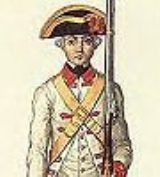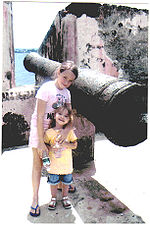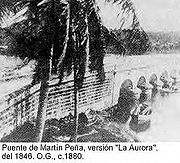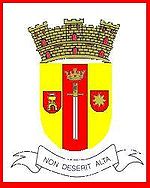
Jose and Francisco Diaz
Encyclopedia
Sergeants José "Pepe" Díaz (1776 - April 30, 1797) and Francisco Díaz (1777 - ?) were two cousins in the Toa Alta Militia who helped defeat Sir Ralph Abercromby
and defend Puerto Rico
from a British
invasion in 1797.
when the island was a Spanish
colony. They were both Sergeants in the Toa Alta Militia, and with their unit were sent to defend San Juan upon the attempted invasion of the island by British forces under the command of Sir Ralph Abercromby.
Ramón de Castro, received the news that Great Britain had invaded the island of Trinidad
. Believing that Puerto Rico would be the next British objective, he decided to put the local militia on alert and to prepare the island's forts against any military action.
 On April 17, 1797, British ships under the command of Sir Ralph Abercromby were unable to penetrate the defenses of "El Morro" and opted to make their attack from the coastal town of Loíza
On April 17, 1797, British ships under the command of Sir Ralph Abercromby were unable to penetrate the defenses of "El Morro" and opted to make their attack from the coastal town of Loíza
, to the east of San Juan. On April 18, British soldiers and German mercenaries ("Hessians") landed on Loíza's beach. Under the command of de Castro, British ships were attacked with artillery and mortar fire from both El Morro and the San Gerónimo fortresses.
On April 20, the British tried to establish a battery on the Cerro del Condado overlooking the Spanish positions to the East. Sargento Mayor (Sergeant Major
) José Díaz set out with 50 men to contain an enemy attack which was being attempted at the rear.
 On April 24, Sergeant Francisco Díaz was chosen to lead a raid against the enemy. He had 70 volunteers, 20 from the Disciplined Militias and 50 from men being sent to prison. At daybreak they set out in pirogue
On April 24, Sergeant Francisco Díaz was chosen to lead a raid against the enemy. He had 70 volunteers, 20 from the Disciplined Militias and 50 from men being sent to prison. At daybreak they set out in pirogue
s (a small, flat-bottomed boat), supported by two gunboats, passing down the San Antonio Channel and landed close to the enemy trenches and batteries. The Spanish artillery batteries
had previously laid down a heavy covering barrage, and as soon as they saw that Francisco Díaz and his troops had landed, they were ordered to maintain and fire only gunpowder from the cannons without firing the cannon balls. This was done to distract the British. The batteries were also prepared to provide cover in case a retreat was necessary.
 Francisco Díaz and his men landed and advanced towards the enemy lines, shooting at the enemy working on the trenches. It was estimated that there were about 300 British soldiers. The British returned fire, but Francisco Díaz continued to advance until, with his saber in hand, he reached the trench with his men, killing or wounding any of the enemy who stood in the way. Those who escaped their attack fled. On taking the trench, Francisco Díaz discovered a cannon battery aimed towards the San Antonio Bridge and the San Gerónimo fortress, capable of accommodating seven cannons and having two 24 pounders and one 12 pounder already in place, along with two howitzers and three mortars. Francisco Díaz did not have the time nor the means to retrieve the artillery and as the British reinforcements were about to counterattack, Díaz and his men jumped into their boats, with a Captain and 13 enemy soldiers which he had taken prisoner and escaped back to the city, this time under the cover of "real" artillery fire from the city. Governor Ramón de Castro would later write that "he observed the action from his position with envy".
Francisco Díaz and his men landed and advanced towards the enemy lines, shooting at the enemy working on the trenches. It was estimated that there were about 300 British soldiers. The British returned fire, but Francisco Díaz continued to advance until, with his saber in hand, he reached the trench with his men, killing or wounding any of the enemy who stood in the way. Those who escaped their attack fled. On taking the trench, Francisco Díaz discovered a cannon battery aimed towards the San Antonio Bridge and the San Gerónimo fortress, capable of accommodating seven cannons and having two 24 pounders and one 12 pounder already in place, along with two howitzers and three mortars. Francisco Díaz did not have the time nor the means to retrieve the artillery and as the British reinforcements were about to counterattack, Díaz and his men jumped into their boats, with a Captain and 13 enemy soldiers which he had taken prisoner and escaped back to the city, this time under the cover of "real" artillery fire from the city. Governor Ramón de Castro would later write that "he observed the action from his position with envy".
 Unable to penetrate the fire power of El Morro and the other fortresses, the British twice tried to take the Martín Peña Bridge, a key passage to the San Juan islet. On April 30, when the British made their second attempt, Sergeant Major José Díaz was among the 800 men assembled by Capt. Luis de Lara to protect the Martín Peña Bridge. The men reached the bridge, but were soon attacked by the British. Capt. de Lara responded with his own battery and he directed his cavalry to the flanks and opened up with musket fire. Among those who died in the battle was Sergeant Major José Díaz who was struck by a shell at the bridge. After fiercely fighting the Spanish forces and local militia, the British were defeated. The British set brush fires to cover their retreat and the fleet sailed off.
Unable to penetrate the fire power of El Morro and the other fortresses, the British twice tried to take the Martín Peña Bridge, a key passage to the San Juan islet. On April 30, when the British made their second attempt, Sergeant Major José Díaz was among the 800 men assembled by Capt. Luis de Lara to protect the Martín Peña Bridge. The men reached the bridge, but were soon attacked by the British. Capt. de Lara responded with his own battery and he directed his cavalry to the flanks and opened up with musket fire. Among those who died in the battle was Sergeant Major José Díaz who was struck by a shell at the bridge. After fiercely fighting the Spanish forces and local militia, the British were defeated. The British set brush fires to cover their retreat and the fleet sailed off.
and Punta Salinas, but they were defeated, and the British troops that had landed on the island were taken prisoner. The British retreated on April 30 to their ships and on May 2 set sail northward. Because of the defeat given to the British forces, governor Ramon de Castro petitioned Spanish King Charles IV
for recognition for the victors; he was promoted to Field Marshal, Sergeant Major José "Pepe" Díaz was posthumously named "The King of Spain's Bravest Soldier", Sergeant Francisco Díaz was promoted to Lieutenant
and was given a pay raise.
Lt. Francisco Díaz was married to Isabel de Castro, who was awarded a monthly pension by the government upon his death. His granddaughter, Isabel Matilde Díaz y Ruiz, married Román Baldorioty de Castro
.
 The people of Toa Alta have honored the Díaz cousins in the design of the town's coat of arms
The people of Toa Alta have honored the Díaz cousins in the design of the town's coat of arms
. The right small shield with the star and eight rays, represent Francisco Díaz and his cousin José, who gave his life in the defense of the Martín Peña bridge. In the Spanish heraldic the star is symbol of the last name Díaz... which means "Son of Diego".
Sergeant Major José Díaz has also become part of the islands folklore. The Puerto Rican "Jíbaro" (peasant) sang the following "copla" (ballad
) about him :
The statue of Juan Ponce de León
situated in the Plaza de San José in Old San Juan was made from the cannons left behind by Sir Ralph Abercromby and his men.
Ralph Abercromby
Sir Ralph Abercromby was a Scottish soldier and politician. He rose to the rank of lieutenant-general in the British Army, was noted for his services during the Napoleonic Wars, and served as Commander-in-Chief, Ireland.He twice served as MP for Clackmannanshire and Kinross-shire, and was...
and defend Puerto Rico
Puerto Rico
Puerto Rico , officially the Commonwealth of Puerto Rico , is an unincorporated territory of the United States, located in the northeastern Caribbean, east of the Dominican Republic and west of both the United States Virgin Islands and the British Virgin Islands.Puerto Rico comprises an...
from a British
Kingdom of Great Britain
The former Kingdom of Great Britain, sometimes described as the 'United Kingdom of Great Britain', That the Two Kingdoms of Scotland and England, shall upon the 1st May next ensuing the date hereof, and forever after, be United into One Kingdom by the Name of GREAT BRITAIN. was a sovereign...
invasion in 1797.
Early years
The Díaz cousins were born and raised in the town of Toa Alta, Puerto RicoToa Alta, Puerto Rico
Toa Alta is a municipality of Puerto Rico located in the northern coast of the island, north of Naranjito; south of Dorado and Toa Baja; east of Vega Alta and Corozal; and west of Bayamón. Toa Alta is spread over eight wards and Toa Alta Pueblo...
when the island was a Spanish
Spanish Empire
The Spanish Empire comprised territories and colonies administered directly by Spain in Europe, in America, Africa, Asia and Oceania. It originated during the Age of Exploration and was therefore one of the first global empires. At the time of Habsburgs, Spain reached the peak of its world power....
colony. They were both Sergeants in the Toa Alta Militia, and with their unit were sent to defend San Juan upon the attempted invasion of the island by British forces under the command of Sir Ralph Abercromby.
Defense of Puerto Rico
On February 17, 1797, the appointed governor of Puerto Rico, BrigadierBrigadier
Brigadier is a senior military rank, the meaning of which is somewhat different in different military services. The brigadier rank is generally superior to the rank of colonel, and subordinate to major general....
Ramón de Castro, received the news that Great Britain had invaded the island of Trinidad
Trinidad
Trinidad is the larger and more populous of the two major islands and numerous landforms which make up the island nation of Trinidad and Tobago. It is the southernmost island in the Caribbean and lies just off the northeastern coast of Venezuela. With an area of it is also the fifth largest in...
. Believing that Puerto Rico would be the next British objective, he decided to put the local militia on alert and to prepare the island's forts against any military action.
Battle of San Juan

Loíza, Puerto Rico
Loíza is a small town and municipality in the northeastern coast of Puerto Rico, north of Canóvanas; east of Carolina; and west of Río Grande. Loíza is spread over 5 wards and Loíza Pueblo...
, to the east of San Juan. On April 18, British soldiers and German mercenaries ("Hessians") landed on Loíza's beach. Under the command of de Castro, British ships were attacked with artillery and mortar fire from both El Morro and the San Gerónimo fortresses.
On April 20, the British tried to establish a battery on the Cerro del Condado overlooking the Spanish positions to the East. Sargento Mayor (Sergeant Major
Sergeant Major
Sergeants major is a senior non-commissioned rank or appointment in many militaries around the world. In Commonwealth countries, Sergeants Major are usually appointments held by senior non-commissioned officers or warrant officers...
) José Díaz set out with 50 men to contain an enemy attack which was being attempted at the rear.

Pirogue
A pirogue is a small, flat-bottomed boat of a design associated particularly with the Cajuns of the Louisiana marsh. In West Africa they were used as traditional fishing boats. These boats are not usually intended for overnight travel but are light and small enough to be easily taken onto land...
s (a small, flat-bottomed boat), supported by two gunboats, passing down the San Antonio Channel and landed close to the enemy trenches and batteries. The Spanish artillery batteries
Artillery battery
In military organizations, an artillery battery is a unit of guns, mortars, rockets or missiles so grouped in order to facilitate better battlefield communication and command and control, as well as to provide dispersion for its constituent gunnery crews and their systems...
had previously laid down a heavy covering barrage, and as soon as they saw that Francisco Díaz and his troops had landed, they were ordered to maintain and fire only gunpowder from the cannons without firing the cannon balls. This was done to distract the British. The batteries were also prepared to provide cover in case a retreat was necessary.


Aftermath
The invasion failed because Puerto Rican volunteers and Spanish troops fought back and defended the island. The continuous flow of reinforcements from various towns of Puerto Rico into San Juan, the inability to break through the Fort San Antonio and San Geronimo line, and the counterattacking pressure of militia and cavalry at the Martín Peña bridge were finally too much for the invaders. The British also attacked AguadillaAguadilla, Puerto Rico
Aguadilla , founded in 1775 by Luis de Córdova, is a city located in the northwestern tip of Puerto Rico bordered by the Atlantic Ocean to the north and west, north of Aguada, and Moca and west of Isabela. Aguadilla is spread over 15 wards and Aguadilla Pueblo...
and Punta Salinas, but they were defeated, and the British troops that had landed on the island were taken prisoner. The British retreated on April 30 to their ships and on May 2 set sail northward. Because of the defeat given to the British forces, governor Ramon de Castro petitioned Spanish King Charles IV
Charles IV of Spain
Charles IV was King of Spain from 14 December 1788 until his abdication on 19 March 1808.-Early life:...
for recognition for the victors; he was promoted to Field Marshal, Sergeant Major José "Pepe" Díaz was posthumously named "The King of Spain's Bravest Soldier", Sergeant Francisco Díaz was promoted to Lieutenant
Lieutenant
A lieutenant is a junior commissioned officer in many nations' armed forces. Typically, the rank of lieutenant in naval usage, while still a junior officer rank, is senior to the army rank...
and was given a pay raise.
Lt. Francisco Díaz was married to Isabel de Castro, who was awarded a monthly pension by the government upon his death. His granddaughter, Isabel Matilde Díaz y Ruiz, married Román Baldorioty de Castro
Román Baldorioty de Castro
Román Baldorioty de Castro distinguished himself as one of Puerto Rico's foremost abolitionists and spokesman for the island's right to self-determination...
.
Legacy

Coat of arms
A coat of arms is a unique heraldic design on a shield or escutcheon or on a surcoat or tabard used to cover and protect armour and to identify the wearer. Thus the term is often stated as "coat-armour", because it was anciently displayed on the front of a coat of cloth...
. The right small shield with the star and eight rays, represent Francisco Díaz and his cousin José, who gave his life in the defense of the Martín Peña bridge. In the Spanish heraldic the star is symbol of the last name Díaz... which means "Son of Diego".
Sergeant Major José Díaz has also become part of the islands folklore. The Puerto Rican "Jíbaro" (peasant) sang the following "copla" (ballad
Ballad
A ballad is a form of verse, often a narrative set to music. Ballads were particularly characteristic of British and Irish popular poetry and song from the later medieval period until the 19th century and used extensively across Europe and later the Americas, Australia and North Africa. Many...
) about him :
- En el puente Martin Peña (On the bridge of Martin Peña)
- Mataron a Pepe Díaz (Pepe Díaz was killed)
- Que era el hombre más valiente (He was the bravest man)
- Que el Rey de España tenía. (that the King of Spain had)
The statue of Juan Ponce de León
Juan Ponce de León
Juan Ponce de León was a Spanish explorer. He became the first Governor of Puerto Rico by appointment of the Spanish crown. He led the first European expedition to Florida, which he named...
situated in the Plaza de San José in Old San Juan was made from the cannons left behind by Sir Ralph Abercromby and his men.
See also
- List of famous Puerto Ricans
- List of Puerto Rican military personnel
- Military history of Puerto RicoMilitary history of Puerto RicoThe recorded military history of Puerto Rico encompasses the period from the 16th century, when Spanish conquistadores battled native Tainos in the rebellion of 1511, to the present employment of Puerto Ricans in the United States Armed Forces in the military campaigns in Afghanistan and...
- Colonel Rafael ContiRafael ContiColonel Rafael Conti, also spelled "Conty" was a Puerto Rican who joined the Spanish Army and was placed in charge of the Puerto Rican Militia in the town of Aguadilla. In 1790, he captured 11 enemy ships involved in smuggling stolen goods. In 1797, he helped defeat Sir Ralph Abercromby and defend...

